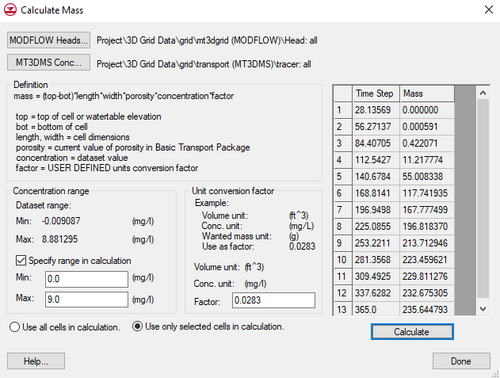GMS:Calculate Mass: Difference between revisions
From XMS Wiki
Jump to navigationJump to search
No edit summary |
No edit summary |
||
| (7 intermediate revisions by the same user not shown) | |||
| Line 1: | Line 1: | ||
{{MT3DMS Links}} | |||
The MT3DMS ''Calculate Mass'' dialog allows the calculation of the mass of a contaminant in the entire model domain or in the selected cells. At the top of the dialog, the '''MODFLOW Heads''' and '''MT3DMS Conc...''' buttons bring up a ''Select Dataset'' dialog where the head and concentration datasets can be selected. All time steps in the datasets can be used or specific time steps can be selected. | The MT3DMS ''Calculate Mass'' dialog allows the calculation of the mass of a contaminant in the entire model domain or in the selected cells. The dialog is reached through the '''Calculate Mass''' command in either [[GMS:MT3DMS Commands|''MT3DMS'']] menu or the ''PHT3D'' menu. The appropriate datasets must already exist in the project before this dialog can be accessed. | ||
At the top of the dialog, the '''MODFLOW Heads''' and '''MT3DMS Conc...''' buttons bring up a ''Select Dataset'' dialog where the head and concentration datasets can be selected. All time steps in the datasets can be used or specific time steps can be selected. Selecting the '''Calculate''' button will populate the table on the right with the mass at each time step. | |||
==Definition== | ==Definition== | ||
| Line 7: | Line 9: | ||
==Concentration Range== | ==Concentration Range== | ||
Allows the specification a range over which the mass will be calculated. This is most useful to ignore negative concentrations that result in MT3DMS simulations. | Allows the specification a range over which the mass will be calculated. This is most useful to ignore negative concentrations that result in MT3DMS simulations. | ||
By default, the range of the selected dataset is used. Turning on the ''Specify range in calculation'' option allows using a specific range inside the dataset by setting the minimum and maximum values. | |||
==Conversion Factor== | ==Conversion Factor== | ||
The | The ''Factor'' determines which units the resulting mass will be displayed in. | ||
[[File:MT3D-CalculateMass.png|none|500 px|Example of the MT3DMS ''Calculate Mass'' dialog.]] | |||
